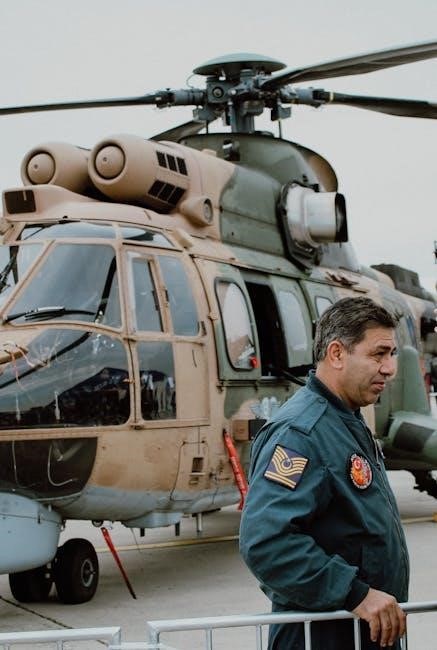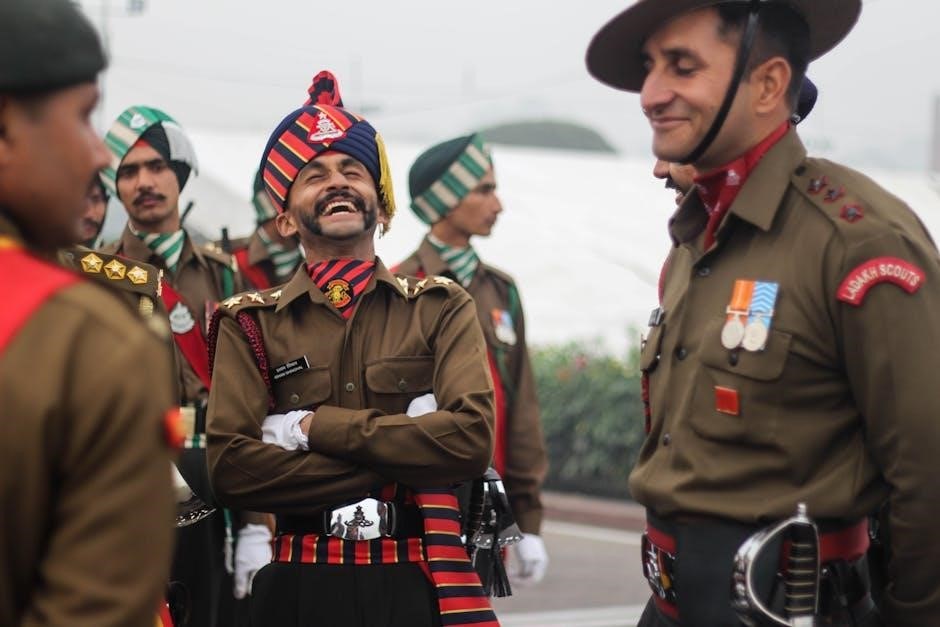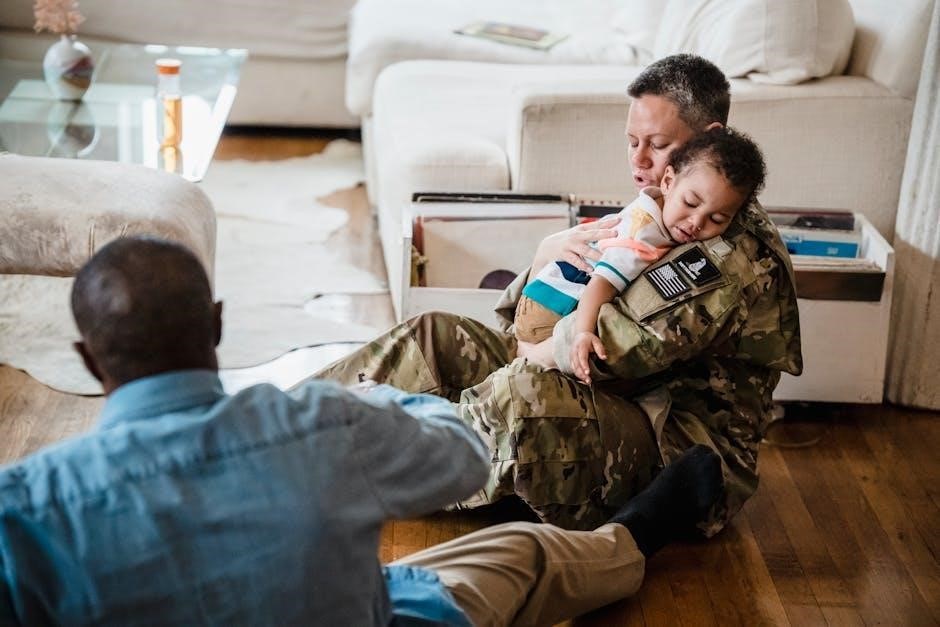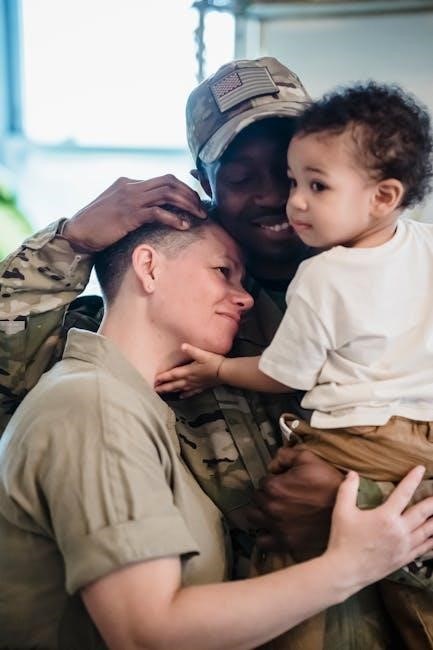Welcome to your comprehensive guide to the Army Operational Camouflage Pattern (OCP) uniform! This resource provides soldiers with essential information about regulations, proper wear, and authorized accessories. Stay informed and maintain a sharp, professional appearance while adhering to Army standards.
The Army Operational Camouflage Pattern (OCP) uniform marks a significant evolution in the U.S. Army’s combat attire. Replacing the Universal Camouflage Pattern (UCP), the OCP was introduced to provide soldiers with enhanced concealment across a wider range of operational environments. This transition reflects the Army’s commitment to equipping its personnel with the most effective gear for mission success.
The OCP uniform, also known as the Scorpion W2 pattern, incorporates a blend of colors designed to blend seamlessly into various terrains, including woodland, desert, and urban landscapes. Its effectiveness stems from its multi-scale pattern, which disrupts the wearer’s outline at different distances. This adaptability ensures that soldiers remain concealed, whether operating in dense forests or open deserts.
Beyond camouflage, the OCP uniform is engineered for comfort and durability. Constructed from a robust fabric blend, it withstands the rigors of combat while providing breathability and flexibility. Features such as adjustable cuffs, reinforced elbows, and multiple pockets enhance functionality, allowing soldiers to carry essential equipment and adapt to changing conditions. Understanding the OCP uniform’s design and purpose is crucial for all soldiers.

Governing Regulations: AR 670-1
Army Regulation 670-1 (AR 670-1) serves as the cornerstone for all matters pertaining to the wear and appearance of Army uniforms, including the Operational Camouflage Pattern (OCP) uniform. This comprehensive regulation outlines the policies and procedures governing proper uniform configuration, authorized accouterments, and standards of personal grooming. Soldiers are expected to adhere strictly to the guidelines outlined in AR 670-1 to maintain a professional and standardized appearance.
AR 670-1 addresses various aspects of the OCP uniform, including patch placement, insignia requirements, and restrictions on modifications. It specifies the authorized locations for name tapes, rank insignia, and unit patches, ensuring uniformity across the force. The regulation also details the circumstances under which certain uniform items, such as cold-weather gear, may be worn.
Furthermore, AR 670-1 emphasizes the importance of personal appearance and hygiene. Soldiers are required to maintain a neat and well-groomed appearance at all times, adhering to standards for haircuts, facial hair, and jewelry. Compliance with AR 670-1 is not only a matter of regulatory adherence but also a reflection of a soldier’s professionalism and commitment to the Army’s values. Regular review of AR 670-1 is essential for staying informed and ensuring compliance.
OCP Patch Placement
Proper OCP patch placement is critical for maintaining a professional and standardized appearance. The U.S. Army prescribes specific locations for each patch, ensuring uniformity across all soldiers. On the left sleeve, the soldier’s unit patch, also known as the Shoulder Sleeve Insignia (SSI), is centered. If the soldier has a combat patch, also known as the SSI-Former Wartime Service (SSI-FWTS), it is placed on the right sleeve, also centered.
Name tapes are sewn above the left and right breast pockets. The “U.S. Army” tape is positioned above the right pocket, while the soldier’s last name is placed above the left. Rank insignia is affixed to the center of the chest, either sewn or pinned, depending on the rank and uniform configuration. Subdued flags are worn on the right shoulder, with the star field facing forward, symbolizing the soldier moving forward.
Adherence to these guidelines ensures a cohesive and professional image for the U.S. Army. Any deviation from these standards is considered a violation of uniform regulations. Consulting official sources, such as AR 670-1, is essential for accurate and up-to-date information. Correct patch placement demonstrates attention to detail and respect for military customs.
Authorized Wear and Restrictions
The Operational Camouflage Pattern (OCP) uniform has specific guidelines regarding authorized wear and restrictions. Soldiers are expected to adhere to these regulations to maintain a professional appearance. The OCP is primarily authorized for year-round duty wear, as determined by the commander. However, certain situations dictate alternative uniform choices.
Wearing distinctive uniforms or uniform items from other U.S. services with civilian clothing is prohibited. This ensures a clear distinction between military and civilian attire. While the OCP is versatile, its wear is restricted in formal civilian settings where a more appropriate dress code is expected. Commanders retain the authority to prescribe specific uniform requirements based on the mission and environment.
When wearing the OCP in a deployed environment, specific modifications may be authorized. These modifications often relate to tactical considerations and environmental factors. It is imperative to consult with the chain of command for clarifications regarding authorized wear and restrictions. Strict adherence to these guidelines upholds the integrity and professionalism of the U.S. Army.
Understanding these regulations is crucial for all soldiers. Staying informed ensures compliance and contributes to a positive representation of the military.

Year-Round Duty Wear Authorization
The Operational Camouflage Pattern (OCP) uniform is authorized for year-round duty wear, providing soldiers with a versatile and functional uniform option suitable for various climates and environments. However, the authorization for year-round wear is ultimately determined by the commander, who considers factors such as mission requirements, local conditions, and unit standards.
This authorization means that unless otherwise directed, soldiers can wear the OCP as their primary duty uniform throughout the year. This reduces the need for multiple uniform types and simplifies logistical considerations. While the OCP is designed for year-round use, proper layering with authorized cold-weather gear is essential during colder months.
Commanders may prescribe alternative uniforms for specific situations, such as formal events or specialized training exercises. These exceptions are communicated through official channels and must be strictly adhered to. The year-round duty wear authorization aims to provide consistency and practicality while allowing commanders the flexibility to address unique operational needs.
It’s crucial for soldiers to stay informed about their unit’s specific uniform policies and any deviations from the standard year-round authorization. Understanding these guidelines ensures compliance and contributes to a professional and cohesive military appearance at all times, reflecting positively on the individual and the U.S. Army.

Wearing OCP as a Physical Training Uniform
While the OCP is primarily designed as a combat and duty uniform, specific guidelines exist regarding its wear during physical training (PT). When authorized by the commander, the OCP can be worn as a PT uniform, ensuring uniformity during group physical activities. However, certain modifications and requirements must be followed to maintain a professional appearance and ensure safety.
When wearing the OCP Combat Uniform for PT, soldiers must adhere to specific regulations regarding attachments and insignia. Name tapes, U.S. Army tapes, rank insignia, and subdued flags are typically required to be worn. This ensures proper identification and maintains military standards, even during physical activities. The only exceptions to these requirements are usually outlined by the unit commander based on the specific training environment and safety considerations.
Modifications to the OCP for enhanced PT performance are generally discouraged, unless specifically authorized by higher command. Rolling up sleeves or blousing trousers in an unauthorized manner is typically prohibited. The focus remains on maintaining a professional image while participating in physical training.
Commanders retain the authority to dictate alternative PT attire based on weather conditions or specific training requirements. During extreme heat, for instance, they may authorize the wear of more breathable athletic gear. Soldiers should always consult their unit’s policies and leadership for clarification on authorized PT uniform options and any deviations from standard OCP wear guidelines.
Flag Placement on the OCP Uniform
Proper flag placement on the Operational Camouflage Pattern (OCP) uniform is essential for adhering to Army regulations and displaying respect for the nation. Generally, all soldiers are required to wear the full-color U.S. flag embroidered insignia on their utility and organizational uniforms, unless deployed to specific combat zones where subdued flags are authorized.
The full-color U.S. flag is worn on the right shoulder sleeve of the OCP uniform. The flag is positioned with the union (the blue field with stars) facing forward, indicating that the soldier is moving forward and the flag is not in retreat. This placement is consistent across all ranks and units within the Army.
In deployed environments, commanders may authorize the wear of subdued flags on the OCP uniform. Subdued flags are typically variations of the camouflage pattern, with muted colors to minimize visibility and enhance operational effectiveness. The subdued flag also adheres to the same orientation as the full-color flag, with the union facing forward.
Flag placement guidelines are outlined in Army Regulation 670-1, which provides detailed instructions on uniform wear and appearance. Soldiers should always consult AR 670-1 and their chain of command for clarification on authorized flag types and placement, particularly when deploying to different operational environments. Adherence to these regulations demonstrates professionalism and respect for the U.S. flag.

Transition from UCP to OCP
The transition from the Universal Camouflage Pattern (UCP) to the Operational Camouflage Pattern (OCP) marked a significant shift in the Army’s combat uniform. The decision to adopt OCP was driven by the need for a more effective camouflage pattern across diverse operational environments. The UCP, while intended to be versatile, proved less effective in certain terrains, leading to the search for a superior alternative.
The Army officially announced the change to OCP in 2015, setting a mandatory possession date for all soldiers to have the new uniform. This transition period allowed soldiers to gradually replace their UCP uniforms with OCP ones, minimizing financial burden and logistical challenges. During this period, both UCP and OCP uniforms were authorized for wear, providing flexibility for soldiers as they acquired the new uniform items.
The transition also involved changes in authorized accessories and gear. While some UCP-era cold weather gear was initially authorized for wear with the OCP uniform, the Army eventually introduced OCP-patterned cold weather items to ensure uniformity and enhanced camouflage effectiveness; This phased approach allowed for a smooth and cost-effective transition while maintaining operational readiness.
The shift from UCP to OCP represents the Army’s commitment to providing soldiers with the best possible equipment for mission success. By adopting a more effective camouflage pattern, the OCP uniform enhances soldier survivability and operational capabilities in a wide range of environments.
Authorized Cold Weather Gear
When the temperature drops, maintaining combat effectiveness requires appropriate cold weather gear. With the Operational Camouflage Pattern (OCP) uniform, soldiers have access to a range of authorized items designed to provide warmth and protection in frigid conditions. Understanding which items are approved and how to properly wear them is crucial for both comfort and adherence to regulations.
Initially, during the transition from the Universal Camouflage Pattern (UCP), some UCP cold weather gear was authorized for wear with the OCP uniform. This allowed soldiers to utilize existing resources while gradually acquiring OCP-patterned replacements. However, the long-term goal was to fully integrate OCP-patterned cold weather items into the standard issue.
The authorized OCP cold weather gear includes items such as the OCP ECWCS (Extended Cold Weather Clothing System) which features multiple layers for adaptable protection. This system typically includes a base layer, insulating mid-layers, and a waterproof, breathable outer shell. Soldiers may also utilize OCP-patterned gloves, hats, and neck gaiters to protect extremities and exposed skin.
Proper wear of cold weather gear is essential. Soldiers should follow layering guidelines to maximize warmth and breathability, avoiding overheating and perspiration buildup. All authorized cold weather items must be clean, serviceable, and worn in accordance with Army regulations. Commanders may provide additional guidance based on specific environmental conditions and mission requirements.
Availability for National Guard and Reservists
Ensuring that National Guard and Reserve soldiers have access to the Operational Camouflage Pattern (OCP) uniform is a critical aspect of Army readiness. These soldiers often balance civilian careers with their military obligations, making timely and convenient access to required uniforms and equipment essential.
The Army has taken steps to improve the availability of OCP uniforms and accessories for National Guard and Reserve personnel. One key initiative involves making the OCP uniform available through ShopMyExchange.com. This online platform allows soldiers, regardless of their rank or active-duty status, to purchase OCP uniforms and related items conveniently.
This accessibility helps alleviate the burden on National Guard and Reserve soldiers who may not have regular access to military clothing sales stores. By offering the OCP uniform online, the Army ensures that these soldiers can obtain the necessary uniform components without significant disruption to their civilian lives.
Furthermore, the Army continues to work on streamlining the uniform issue process for National Guard and Reserve units. This includes ensuring that units have adequate supplies of OCP uniforms and accessories to equip their soldiers during training and deployments. Regular communication and coordination between active duty, National Guard, and Reserve components are vital to maintaining uniform readiness across the force.